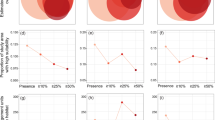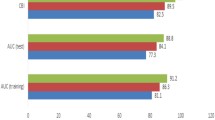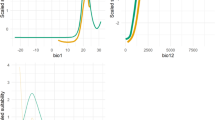Abstract
Monitoring and species distribution models (SDMs) are increasingly used to support conservation planning but are rarely projected at a very high resolution for conservation management. In this study, we compared the population distribution and size of five invasive plant species along an 18 km alluvial system in Switzerland, over a period of 11 years. Exhaustive inventories of past (2001) to current (2012) populations showed a massive increase in invaded areas over the eleven years. Impatiens glandulifera and Reynoutria japonica were the species with the largest increases in population number and size. The ecological preferences of each species were then modelled at 1 m resolution, using environmental variables expressing topography, disturbances, dispersal, soil texture and light availability. SDMs successfully depicted the niches at very high resolution. Some of the important predictors (e.g., canopy density, distance to river) would have been unhelpful at a coarser resolution. From these very-high-resolution models, we predicted the potential distribution and abundance of species and derived two indices indicating the amount of habitat still available for future species colonisation, crucial information for management. Large, empty areas were predicted to be suitable for each species, suggesting that the observed increase in population size may continue in the future. The two proposed range-filling indices and abundance models may be used efficiently in future studies at very fine resolution to prioritise eradication efforts in previously invaded areas and controls in areas at high risk of invasion. To our knowledge, this is the first study investigating the efficiency of SDMs to predict invasions at such a fine resolution.





Similar content being viewed by others
References
Allouche O, Tsoar A, Kadmon R (2006) Assessing the accuracy of species distribution models: prevalence, kappa and the true skill statistic (TSS). J Appl Ecol 43:1223–1232
Araújo MB, New M (2007) Ensemble forecasting of species distributions. Trends Ecol Evol 22:42–47
Barney JN, Tharayil N, DiTommaso A, Bhowmik PC (2006) The biology of invasive alien plants in Canada. 5. Polygonum cuspidatum Sieb. & Zucc. [= Fallopia japonica (Houtt.) Ronse Decr.]. Can J Plant Sci 86:887–905
Bimova K, Mandak B, Kasparova I (2004) How does Reynoutria invasion fit the various theories of invasibility? J Veg Sci 15:495–504
Bio AM, De Becker P, De Bie E et al (2002) Prediction of plant species distribution in lowland river valleys in Belgium: modelling species response to site conditions. Biodivers Conserv 11:2189–2216
Boyce MS, Vernier PR, Nielsen SE, Schmiegelow FK (2002) Evaluating resource selection functions. Ecol Modell 157:281–300. doi:10.1016/S0304-3800(02)00200-4
Bradley BA (2013) Distribution models of invasive plants over-estimate potential impact. Biol Invasions 15:1417–1429
Burkart M (2001) River corridor plants (Stromtalpflanzen) in central European lowland: a review of a poorly understood plant distribution pattern. Glob Ecol Biogeogr 10:449–468
Davis MA, Grime JP, Thompson K (2000) Fluctuating resources in plant communities: a general theory of invasibility. J Ecol 88:528–534
Dolédec S, Chessel D (1987) Rythmes saisonniers et composantes stationnelles en milieu aquatique. I: description d’un plan d’observation complet par projection de variables. Acta Oecol 8:403–426
Dray S, Dufour AB (2007) The ade4 package: implementing the duality diagram for ecologists. J Stat Softw 22:1–20
Dubuis A, Giovanettina S, Pellissier L et al (2013) Improving the prediction of plant species distribution and community composition by adding edaphic to topo-climatic variables. J Veg Sci 24:593–606
Ehrenfeld JG (2003) Effects of exotic plant invasions on soil nutrient cycling processes. Ecosystems 6:503–523
Elith J, Leathwick JR, Hastie T (2008) A working guide to boosted regression trees. J Anim Ecol 77:802–813
Elith J, Phillips SJ, Hastie T et al (2011) A statistical explanation of MaxEnt for ecologists. Divers Distrib 17:43–57
Engler R, Guisan A, Rechsteiner L (2004) An improved approach for predicting the distribution of rare and endangered species from occurrence and pseudo-absence data. J Appl Ecol 41:263–274
Eschtruth AK, Battles JJ (2009) Assessing the relative importance of disturbance, herbivory, diversity, and propagule pressure in exotic plant invasion. Ecol Monogr 79:265–280
Fielding AH, Bell JF (1997) A review of methods for the assessment of prediction errors in conservation presence/absence models. Environ Conserv 24:38–49
Friedman J, Hastie T, Tibshirani R (2000) Additive logistic regression: a statistical view of boosting. Ann Stat 28:337–407
Gallien L, Douzet R, Pratte S et al (2012) Invasive species distribution models–how violating the equilibrium assumption can create new insights. Glob Ecol Biogeogr 21:1126–1136
Growns I, Rourke M, Gilligan D (2013) Toward river health assessment using species distributional modeling. Ecol Indic 29:138–144
Guillera-Arroita G, Hauser CE, Mccarthy MA (2014) Optimal surveillance strategy for invasive species management when surveys stop after detection. Ecol Evol 4:1751–1760
Guisan A, Thuiller W (2005) Predicting species distribution: offering more than simple habitat models. Ecol Lett 8:993–1009
Guisan A, Tingley R, Baumgartner JB et al (2013) Predicting species distributions for conservation decisions. Ecol Lett 16:1424–1435
Heinänen S, Erola J, Von Numers M (2012) High resolution species distribution models of two nesting water bird species: a study of transferability and predictive performance. Landsc Ecol 27:545–555
Hijmans RJ, Phillips S, Leathwick J, Elith J (2011) Dismo: Species distribution modeling. R package version 0.7– 17. http://cran.r-project.org/package=dismo
Hirzel AH, Le Lay G, Helfer V et al (2006) Evaluating the ability of habitat suitability models to predict species presences. Ecol Modell 199:142–152
Hulme PE (2003) Biological invasions: winning the science battles but losing the conservation war? Oryx 37:178–193
Kasperek G (2004) Fluctuations in numbers of neophytes, especially Impatiens glandulifera, in permanent plots in a west German floodplain during 13 years. NEOBIOTA 3:27–37
Keller CA, Hill M, Vollmer MK et al (2012) European emissions of halogenated greenhouse gases inferred from atmospheric measurements. Environ Sci Technol 46:217–225
Koop AL, Fowler L, Newton LP, Caton BP (2012) Development and validation of a weed screening tool for the United States. Biol Invasions 14:273–294
Kremen C, Cameron A, Moilanen A et al (2008) Aligning conservation priorities across taxa in Madagascar with high-resolution planning tools. Science (80-) 320:222–226
Kulhanek SA, Leung B, Ricciardi A (2011) Using ecological niche models to predict the abundance and impact of invasive species: application to the common carp. Ecol Appl 21:203–213
Lachat T, Pauli D, Gonseth Y et al (2010) Wandel der Biodiversität in der Schweiz seit 1990, Ist die Talsohle erreicht?. Haupt Verl, Berne
Lahoz-Monfort JJ, Guillera-Arroita G, Wintle BA (2014) Imperfect detection impacts the performance of species distribution models. Glob Ecol Biogeogr 23:504–515
Lake JC, Leishman MR (2004) Invasion success of exotic plants in natural ecosystems: the role of disturbance, plant attributes and freedom from herbivores. Biol Conserv 117:215–226
Landolt E, Bäumler B, Erhardt A, et al. (2010) Flora Indicativa. Ecological indicator values and biological attributes of the Flora of Switzerland and the Alps, Haupt Verl. Berne
Leung B, Lodge DM, Finnoff D et al (2002) An ounce of prevention or a pound of cure: bioeconomic risk analysis of invasive species. Proc R Soc 269:2407–2413
Maskell LC, Bullock JM, Smart SM et al (2006) The distribution and habitat associations of non-native plant species in urban riparian habitats. J Veg Sci 17:499–508
McCarthy MA, Moore JL, Morris WK et al (2013) The influence of abundance on detectability. Oikos 122:717–726
McCullagh P, Nelder JA (1989) Generalized linear models, 2nd edn. Chapman and Hall, London
Merow C, Smith MJ, Silander JA (2013) A practical guide to MaxEnt for modeling species’ distributions: what it does, and why inputs and settings matter. Ecography (Cop) 36:1058–1069
Miller NP, Matlack GR (2010) Population expansion in an invasive grass, Microstegium vimineum: a test of the channelled diffusion model. Divers Distrib 16:816–826
Morard E (2001) Cartographie et état actuel de quatre plantes potentiellement invasives le long de la Venoge. Master report, University of Lausanne (Unpublished)
Perrins J, Fitter A, Williamson M (1993) Population biology and rates of invasion of three introduced Impatiens species in the British Isles. J Biogeogr 20:33–44
Phillips SJ, Anderson RP, Schapire RE (2006) Maximum entropy modeling of species geographic distributions. Ecol Modell 190:231–259
Pysek P, Hulme PE (2005) Spatio-temporal dynamics of plant invasions: linking pattern to process. Ecoscience 12:302–315
Pysek P, Prach K (1993) Plant invasions and the role of riparian habitats: a comparison of four species alien to central Europe. J Biogeogr 20:413–420
Pysek P, Chytry M, Pergl J et al (2012) Plant invasions in the Czech Republic: current state, introduction dynamics, invasive species and invaded habitats. Preslia 84:575–629
R Development Core Team (2011) R: a Language and Environment for Statistical Computing. The R Foundation for Statistical Computing, Vienna
Renöfält BM, Jansson R, Nilsson C (2005) Spatial patterns of plant invasiveness in a riparian corridor. Landsc Ecol 20:165–176
Ricciardi A (2003) Predicting the impacts of an introduced species from its invasion history: an empirical approach applied to zebra mussel invasions. Freshw Biol 48:972–981
Richardson DM, Allsopp N, D’Antonio CM et al (2000) Plant invasions—the role of mutualisms. Biol Rev Camb Philos Soc 75:65–93
Ridgeway G (1999) The state of boosting. Comput Sci Stat 31:172–181
Seo C, Thorne JH, Hannah L, Thuiller W (2009) Scale effects in species distribution models: implications for conservation planning under climate change. Biol Lett 5:39–43
Swanton CJ, Cavers PB, Clements DR, Moore MJ (1992) The biology of Canadian weeds. 101. Helianthus tuberosus L. Can J Plant Sci 72:1367–1382
Tallent-Halsell NG, Watt MS (2009) The invasive Buddleja davidii (Butterfly bush). Bot Rev 75:292–325
Thuiller W, Richardson DM, Pysek P et al (2005) Niche-based modelling as a tool for predicting the risk of alien plant invasions at a global scale. Glob Chang Biol 11:2234–2250
Thuiller W, Lafourcade B, Araujo M (2010) Presentation manual for BIOMOD. University Joseph Fourier, Laboratoire d’écologie Alpine, Grenoble
Tickner DP, Angold PG, Gurnell AM, Mountford JO (2001) Riparian plant invasions: hydrogeomorphological control and ecological impacts. Prog Phys Geogr 25:22–52
Václavík T, Meentemeyer RK (2009) Invasive species distribution modeling (iSDM): are absence data and dispersal constraints needed to predict actual distributions? Ecol Modell 220:3248–3258
Venables WN, Ripley BD (2002) Modern applied statistics with S, 4th edn. Springer, New York
Vicente J, Randin CF, Gonçalves J et al (2011) Where will conflicts between alien and rare species occur after climate and land-use change? A test with a novel combined modelling approach. Biol Invasions 13:1209–1227
Von Blotzheim UNG (1988) Handbuch der Vögel Mitteleuropas Band 11/II. AULA-Verlag, Wiesbaden
Walther G, Post E, Convey P et al (2002) Ecological responses to recent climate change. Nature 416:389–395
Ward JV, Tockner K, Arscott DB, Claret C (2002) Riverine landscape diversity. Freshw Biol 47:517–539
Wyse DL, Young FL, Jones RJ (1986) Influence of Jerusalem Artichoke (Helianthus tuberosus) density and duration of interference on soybean (Glycine max) growth and yield. Weed Sci 34:243–247
Zweig MH, Campbell G (1993) Receiver-operating Characteristic (ROC) plots: a fundamental evaluation tool in clinical medicine. Clin Chem 39:561–577
Acknowledgments
Thanks to Stuart Lane and Nathalie Diaz for their assistance with soil sample analysis, Anne Freitag and the Zoological Museum of Lausanne for the loan of the spherical densiometer, and Robin Gray, Anne-Béatrice Dufour, Jérôme Pellet, Joslin Moore and two anonymous reviewers for their helpful comments on previous drafts.
Author information
Authors and Affiliations
Corresponding author
Additional information
Patrice Descombes and Blaise Petitpierre shares co-first authorship.
Antoine Guisan and Pascal Vittoz shares co-last authorship.
Electronic supplementary material
Below is the link to the electronic supplementary material.
Rights and permissions
About this article
Cite this article
Descombes, P., Petitpierre, B., Morard, E. et al. Monitoring and distribution modelling of invasive species along riverine habitats at very high resolution. Biol Invasions 18, 3665–3679 (2016). https://doi.org/10.1007/s10530-016-1257-4
Received:
Accepted:
Published:
Issue Date:
DOI: https://doi.org/10.1007/s10530-016-1257-4




